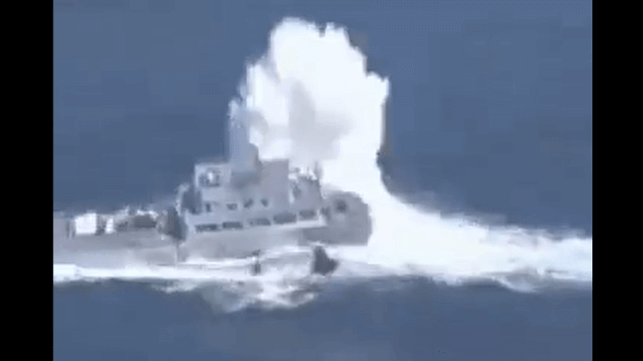U.S. and China Conduct Back-to-Back Sinking Exercises in the Pacific

Within the span of a week, U.S. and Chinese forces have both announced new sinking exercises in the Pacific, both targeting amphibious assault vessels. Sinking exercises are an important test of naval capabilities, and also send a deterrent message signaling the ability to destroy surface targets.
In a message commemorating the 70th anniversary of the PLA Navy submarine force, China's military released a new video of a heavy torpedo striking a landing ship from the stern, partially lifting the vessel out of the water. The vessel was in motion at the time of the attack - a practice long abandoned by Western forces - and the strike appeared to come from astern. This suggests the use of a wake-homing torpedo, according to analysts at The War Zone.
The target was an older Type 074 landing ship, constructed during the 1990s at Wuhu Shipyard. The vessels were an evolution of Cold War-era designs, and are aging out of service with the People's Liberation Army Navy. They are also used by the armed forces of Sri Lanka and Bangladesh, in small numbers. The 100-dwt vessels have a rated sea speed of 18 knots - making them smaller and faster than the nearest American equivalent, the U.S. Army's Runnymede-class - and they can carry a small payload of up to 350 soldiers or two tanks. As small-vessel amphibious assault and resupply operations are a key element of U.S. warfighting plans in the Pacific, the Chinese test could be viewed as messaging to China's primary naval competitor.
A Type 074 LST was used in a SINKEX, getting torpedoed by a PLAN submarine. Via ?????/Wb pic.twitter.com/BEtpsAljYn
— Alex Luck (@AlexLuck9) June 16, 2024
Separately, U.S. and French forces announced a recent sinking exercise targeting a decommissioned amphib, the Austin-class amphibious transport dock USS Cleveland. The operation occurred last week, about 40 nautical miles offshore at an unspecified location in the North Pacific. Photo captions released by the U.S. Navy suggest that it involved a squadron of U.S. Marine Corps strike fighters based out of an airfield on Guam. The carrier USS Ronald Reagan was also conducting air operations in the Philippine Sea at about the same time.
U.S. Pacific Fleet emphasized the safe and environmentally-friendly nature of the sinking. "Each SINKEX is conducted in strict compliance with applicable U.S. environmental laws, regulations, and permit requirements," Pacific Fleet said in a statement. "In addition, each SINKEX vessel undergoes a rigorous cleaning process, in accordance with Environmental Protection Agency (EPA) standards."

that matters most
Get the latest maritime news delivered to your inbox daily.
Imagery of USS Cleveland's sinking was not released.
The sinking preceded a large-scale allied naval exercise within the Philippines' exclusive economic zone, which included participation by French, Japanese, Canadian and Philippine forces. Tensions between the Philippines and Chinese forces are running high after the enactment of new, more aggressive rules of engagement for the China Coast Guard - and a violent altercation between the two sides at Second Thomas Shoal on Monday.
